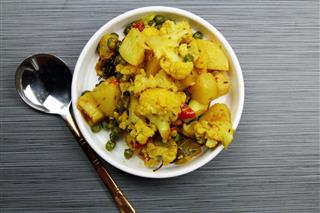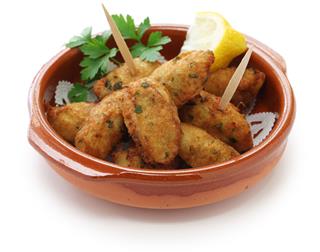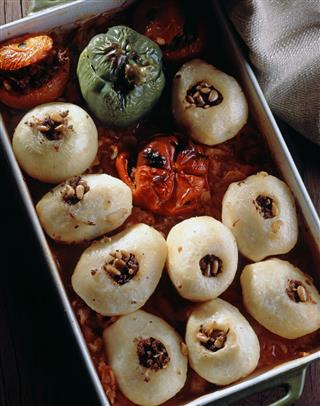
If you feel that your stock of potatoes at home is huge, freezing is a very effective way of preserving the excess spuds. However, it is important that the process of freezing is done just right, or the potatoes may spoil on thawing.
During the 1800s, gardeners living in cold regions would store their fresh harvest of potatoes in metal tins, that were buried underground. The winter frost would keep the potatoes fresh till they were dug out in spring.
Potatoes are one of the most versatile vegetables available to man. Not only can they be prepared in lots of ways, they are so tasty that most meals feel incomplete without a potato element. So, obviously, you are overjoyed when your potato harvest is way bigger than expected, or when you get a very good deal to buy potatoes from your local supermarket. However, this becomes a problem when you can’t use the potatoes fast enough, and need to find ways to preserve them.
Freezing is a preservation method that immediately comes to mind. However, simply tossing the raw spuds into your freezer will not work. There is a very high chance that the potatoes will turn black once they thaw, making them inedible. So, can you freeze potatoes? Yes, you can, provided they are prepared correctly before freezing. Let us now look at the best methods on how to freeze potatoes without them turning black.
Method 1:
- Choose smooth-skinned, new potatoes, and wash them thoroughly.
- If you don’t like your spuds with skin, peel them off.
- In a vessel, put some water to boil. (1 gallon for every pound of potatoes to be prepared.)
- Blanch the potatoes for 3 – 5 minutes, depending on their size.
- Take the potatoes out of the hot water and immediately transfer them into an ice-cold water bath. This will halt the cooking process.
- Pack the spuds into air-tight containers or into Ziploc bags. Use a straw to remove as much air as you can, and seal the potatoes.
- Put the sealed bags or containers into the freezer, and you can now use these potatoes for a long time to come, depending on how cold the temperature of your freezer is (colder is better).
Method 2:
- Peel the potatoes and dice them into 1-inch cubes.
- Blanch the potato cubes in salted water for 5 minutes.
- On a baking tray, apply some non-stick cooking spray, and evenly spread the blanched cubes on the tray.
- Carefully keep the tray inside the freezer till the cubes are frozen solid.
- Take the tray out, and put the cubes inside air-tight containers or Ziploc bags, and seal them.
- Place these containers in the freezer till you want to use them.
Method 1:
- Grate/shred the potatoes you need for making hash browns.
- Put the grated potatoes into an ice-cold water bath.
- In another large vessel, bring some water to boil. Take the potatoes out of the water bath, and blanch them in the boiling water till they are slightly tender.
- Apply some cooking spray to a tray.
- Take out the potatoes from the boiling water, and drain them thoroughly.
- Distribute the shredded spuds into hash brown shaped patties, place them evenly across the tray, and freeze them till they turn solid.
- Place the hash browns in freezer containers and bags till you need to use them.
Method 2:
- Grate the potatoes and wash with cold water.
- Drain the water thoroughly, and make hash brown patties.
- Shallow-fry till lightly browned.
- Cool and flash freeze.
Method 3:
- Scrub and clean the skin of the potatoes thoroughly.
- Pierce the skin of the spuds with a fork, and bake for 1½ hours at 350 degree Fahrenheit.
- Allow the potatoes to cool, and then peel them.
- Grate/shred the potatoes and evenly spread them out on a tray.
- Freeze them in a tray till solid. Then, transfer them to freezer bags, and freeze till you want to use them.
Method 1:
- Peel and cut the potatoes lengthwise, into fries-shaped sticks.
- In a vessel of boiling salted water, blanch the potatoes till they turn slightly tender.
- On a tray sprayed with cooking spray, drain and evenly place the blanched fries.
- Freeze till the fries turn solid, and place them in freezer bags for later use.
Method 2:
- Select some mature potatoes for this method, which have been stored for at least a month.
- Peel and cut the spuds into fries-shaped strips.
- Rinse them immediately in cold water, and drain.
- In a shallow tray, place the fries and evenly coat them with oil.
- Bake in the oven till the fries turn into a very light-golden color.
- Cool these fries and freeze them in airtight containers or bags for later use.
Method 3:
- Cut the potatoes into strips.
- Rinse in cold water, and drain thoroughly.
- Deep-fry the potato strips till they are cooked, but not browned.
- Drain the excess oil with some absorbent paper towels.
- Flash-freeze them in the deepest part of your freezer. Leave for later use.
Method 1:
- You can use this method to freeze the spuds without blanching. To do so, first, you need to prepare your version of twice-baked potatoes.
- On a sprayed tray, place the halves evenly, and freeze till solid. Store in containers and bags for later use.
- When using, bake the frozen potatoes for 40 minutes at 350 degrees Fahrenheit.
Method 2:
- Bake halved potatoes with skins till cooked.
- Scoop out the potato flesh, mash it, and put it back into the skins.
- Wrap these potatoes with foil or cling film, and freeze. Use in 2 – 3 weeks.
Method:
- Prepare mashed potatoes as per your usual recipe.
- Cool the mash in the refrigerator, and make patties of the mash.
- Freeze the patties on a sprayed baking tray, till solid.
- Transfer the mash patties into bags or containers, and save till you want to use them.
Method:
- Prepare roast potatoes as per your usual recipe.
- Allow the potatoes to cool completely, before freezing them in moisture-free bags or containers.
- Baking potatoes like Yukon gold spuds freeze much better than red potatoes.
- Thaw the potatoes gradually to room temperature rather than trying to speed up the process. This will decrease the chances of discoloration. However, the best way is to only partially thaw, before cooking in really hot oil or an oven.
- Blanching a potato must be done correctly. If the blanching is done for too long, the spuds will turn to mush. However, if the blanching is stopped early, it can cause the potatoes to change color faster than normal.
- Draining the water thoroughly after blanching is very important. Use absorbent towels for this purpose.
- Choose potatoes with less starch to avoid excessive browning while cooking
- Add vinegar or lemon juice to the potatoes before or during the blanching process. This will keep the spuds from going runny and soft.
- Air drying the potatoes after blanching can give crispy French fries with soft interiors.
- Defrosting mashed potatoes in a refrigerator for 7 – 8 hours is a better option than defrosting at room temperature.
- If you freeze potatoes before frying, it will give you better French fries than frying directly after blanching.
- If you have potatoes of different sizes, it is always better to blanch, fry, or freeze those of a similar size together, and other sizes in separate batches.
- It is important that there is minimal air in the container or bag used for freezing. A good way is to suck out any air with a straw while sealing the bags.
- Do not fill the potatoes to the brim of the bags/containers. Leave at least a half-inch gap between the top of the container to the potatoes.
- Always dunk the potatoes into ice-cold water immediately after blanching, to avoid making them soggy.
- New potatoes are good for frying whole or in halves, but for fries and other cuts, it is better to use potatoes that have been stored for at least 30 days. However, whole potatoes will last much longer than if they are cut.
- Using very hot oil that is just below smoking will give the best results while cooking frozen French fries.
- Sometimes, thawed potatoes may not smell or taste normal, despite their good appearance. Discard such potatoes, as they can risk you getting sick.
- Freezing blanched potatoes before roasting will give a crisp outside and fluffy inside to roast potatoes.
- Add a little sour cream to frozen mashed potatoes while thawing, to get a better consistency.
Despite all the above recipes, it is important to note that most chefs and culinary experts prefer freshly-cooked potatoes to frozen ones, as freezing gradually decreases the flavor and texture of the spuds. Use your frozen potatoes within a month to get the best results.


